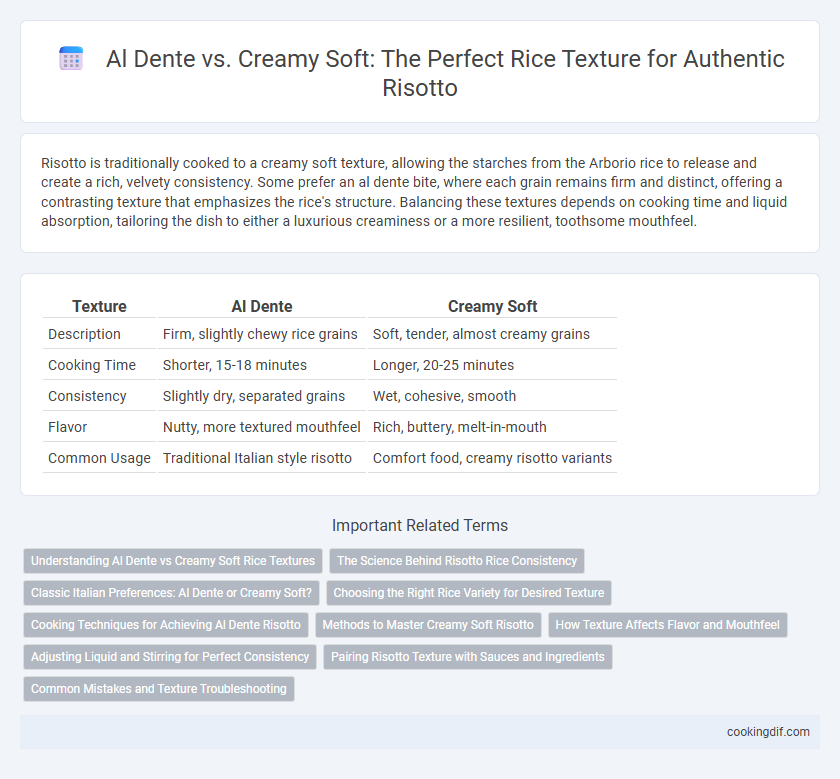Risotto is traditionally cooked to a creamy soft texture, allowing the starches from the Arborio rice to release and create a rich, velvety consistency. Some prefer an al dente bite, where each grain remains firm and distinct, offering a contrasting texture that emphasizes the rice's structure. Balancing these textures depends on cooking time and liquid absorption, tailoring the dish to either a luxurious creaminess or a more resilient, toothsome mouthfeel.
Table of Comparison
| Texture | Al Dente | Creamy Soft |
|---|---|---|
| Description | Firm, slightly chewy rice grains | Soft, tender, almost creamy grains |
| Cooking Time | Shorter, 15-18 minutes | Longer, 20-25 minutes |
| Consistency | Slightly dry, separated grains | Wet, cohesive, smooth |
| Flavor | Nutty, more textured mouthfeel | Rich, buttery, melt-in-mouth |
| Common Usage | Traditional Italian style risotto | Comfort food, creamy risotto variants |
Understanding Al Dente vs Creamy Soft Rice Textures
Al Dente risotto rice offers a firm, slightly chewy texture that maintains distinct grains, enhancing the overall bite and mouthfeel. Creamy soft risotto results from prolonged cooking and starch release, creating a velvety, smooth consistency where grains blend together. Understanding the balance between al dente and creamy soft rice textures helps achieve the desired richness and structural contrast in authentic risotto dishes.
The Science Behind Risotto Rice Consistency
The science behind risotto rice consistency lies in the starch composition and cooking technique of short-grain varieties such as Arborio or Carnaroli, which release amylopectin to create a creamy texture without losing firmness. Achieving the perfect "al dente" balance means lightly tenderizing the grains while retaining a slight resistance, whereas a creamy soft risotto results from prolonged stirring and gradual liquid absorption that breaks down starch granules more thoroughly. Understanding the interplay between starch gelatinization, water absorption, and heat control is essential for mastering the desired risotto texture.
Classic Italian Preferences: Al Dente or Creamy Soft?
Classic Italian risotto traditionally embraces a creamy soft texture achieved by gradually stirring Arborio or Carnaroli rice, allowing the starch to release and create a rich, velvety consistency. While the rice remains tender, it retains a slight firmness in the center--true al dente--balancing texture without becoming mushy. This harmony between creamy softness and subtle bite defines the authentic Italian risotto experience.
Choosing the Right Rice Variety for Desired Texture
Selecting the appropriate rice variety directly influences the texture of risotto, with Arborio rice favored for its creamy soft consistency due to high starch content. Carnaroli rice offers a balanced option, maintaining an al dente firmness while still achieving a rich creaminess. Vialone Nano rice provides a slightly firmer bite, ideal for those preferring a distinct al dente texture without sacrificing the dish's signature creaminess.
Cooking Techniques for Achieving Al Dente Risotto
Achieving an al dente risotto requires precise control of cooking time and liquid absorption to ensure the Arborio rice grains remain tender yet firm in the center. Gradual addition of hot broth combined with consistent stirring allows the rice to release starch slowly, creating a creamy texture while maintaining bite. Avoiding overcooking preserves the ideal texture contrast, essential for authentic risotto with distinguishable grains.
Methods to Master Creamy Soft Risotto
Mastering creamy soft risotto requires using Arborio or Carnaroli rice varieties known for their high starch content, which provides the signature velvety texture. Gradual addition of warm broth in small increments while continuously stirring allows the rice to release starch uniformly, creating a rich and luscious consistency. Controlled heat and patient cooking ensure the grains become tender yet preserve slight firmness without turning mushy, achieving the ideal balance for creamy risotto.
How Texture Affects Flavor and Mouthfeel
Al dente risotto features rice grains with a firm core, providing a slightly chewy texture that enhances the nutty and toasted flavors by preserving the integrity of each grain. Creamy soft risotto offers a smooth, velvety mouthfeel where starch releases more fully, creating a rich, comforting taste and luxurious consistency. The choice between al dente and creamy soft textures directly influences the balance between subtle flavor nuances and the overall sensory experience of the dish.
Adjusting Liquid and Stirring for Perfect Consistency
Achieving the perfect risotto texture hinges on balancing the amount of liquid and the stirring technique; Al Dente rice requires slightly less liquid with careful, less frequent stirring to maintain firmness, while a creamy soft texture demands gradual addition of broth and constant gentle stirring to release the starches fully. Using high-quality Arborio or Carnaroli rice enhances starch absorption, crucial for the creamy consistency, while precise heat control ensures the grains cook evenly without becoming mushy. Adjusting the liquid temperature and adding it incrementally promotes optimal texture, allowing the risotto to be finished with a glossy, luscious finish that defines an expertly prepared dish.
Pairing Risotto Texture with Sauces and Ingredients
Al dente risotto offers a firm, slightly chewy texture that pairs well with lighter, broth-based sauces and fresh, crisp ingredients like peas or asparagus, enhancing their natural flavors without overwhelming the palate. Creamy soft risotto, characterized by its rich, velvety consistency, complements hearty, flavor-intense sauces such as mushroom ragu or truffle cream, providing a luxurious mouthfeel that balances robust ingredients. Selecting risotto texture according to sauce weight and ingredient moisture ensures a harmonious dish where each component enhances the overall culinary experience.
Common Mistakes and Texture Troubleshooting
Common mistakes in risotto texture often involve cooking the rice either too al dente or overly creamy soft, resulting in imbalance between firmness and creaminess. Undercooking causes a hard center, while overcooking breaks down starch granules excessively, turning the risotto mushy. To troubleshoot, monitor cooking time closely and gradually add broth, stirring gently to achieve the perfect tender yet slightly firm arborio or carnaroli rice texture.
Al Dente vs Creamy Soft for rice texture Infographic

 cookingdif.com
cookingdif.com